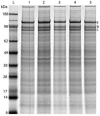Prostasomes: Their Characterisation: Implications for Human Reproduction: Prostasomes and Human Reproduction
- PMID: 26178851
- PMCID: PMC7120776
- DOI: 10.1007/978-3-319-18881-2_9
Prostasomes: Their Characterisation: Implications for Human Reproduction: Prostasomes and Human Reproduction
Abstract
The prostate is a principal accessory genital gland that is vital for normal fertility. Epithelial cells lining the prostate acini release in a defined fashion (exocytosis) organellar nanosized structures named prostasomes. They are involved in the protection of sperm cells against immune response in the female reproductive tract by modulating the complement system and by inhibiting monocyte and neutrophil phagocytosis and lymphocyte proliferation. The immunomodulatory function most probably involves small non-coding RNAs present in prostasomes. Prostasomes have also been proposed to regulate the timing of sperm cell capacitation and induction of the acrosome reaction, since they are rich in various transferable bioactive molecules (e.g. receptors and enzymes) that promote the fertilising ability of sperm cells. Antigenicity of sperm cells has been well documented and implicated in involuntary immunological infertility of human couples, and antisperm antibodies (ASA) occur in several body fluids. The propensity of sperm cells to carry attached prostasomes suggests that they are a new category of sperm antigens. Circulating human ASA recognise prostasomes, and among 12 identified prostasomal antigens, prolactin- inducible protein (95 %) and clusterin (85 %) were immunodominant at the expense of the other 10 that were sporadically occurring.
Figures


Similar articles
-
Prostasomes--their effects on human male reproduction and fertility.Hum Reprod Update. 2006 May-Jun;12(3):283-92. doi: 10.1093/humupd/dmi052. Epub 2005 Dec 22. Hum Reprod Update. 2006. PMID: 16373403 Review.
-
Prostasomes: extracellular vesicles from the prostate.Reproduction. 2013 Nov 16;147(1):R1-14. doi: 10.1530/REP-13-0358. Print 2014 Jan. Reproduction. 2013. PMID: 24149515 Review.
-
Prostasomes: current concepts.Prostate. 2000 May 15;43(3):169-74. doi: 10.1002/(sici)1097-0045(20000515)43:3<169::aid-pros2>3.0.co;2-d. Prostate. 2000. PMID: 10797491 Review.
-
Human prostasomes express CD48 and interfere with NK cell function.Immunobiology. 2011 Jan-Feb;216(1-2):41-6. doi: 10.1016/j.imbio.2010.03.002. Epub 2010 Mar 18. Immunobiology. 2011. PMID: 20382443
-
Human prostasomes an extracellular vesicle - Biomarkers for male infertility and prostrate cancer: The journey from identification to current knowledge.Int J Biol Macromol. 2020 Mar 1;146:946-958. doi: 10.1016/j.ijbiomac.2019.09.218. Epub 2019 Nov 12. Int J Biol Macromol. 2020. PMID: 31730983 Review.
Cited by
-
Exosome Composition and Seminal Plasma Proteome: A Promising Source of Biomarkers of Male Infertility.Int J Mol Sci. 2020 Sep 24;21(19):7022. doi: 10.3390/ijms21197022. Int J Mol Sci. 2020. PMID: 32987677 Free PMC article. Review.
-
The Drosophila Accessory Gland as a Model for Prostate Cancer and Other Pathologies.Curr Top Dev Biol. 2017;121:339-375. doi: 10.1016/bs.ctdb.2016.06.001. Epub 2016 Jul 25. Curr Top Dev Biol. 2017. PMID: 28057306 Free PMC article. Review.
-
Role of Antisperm Antibodies in Infertility, Pregnancy, and Potential forContraceptive and Antifertility Vaccine Designs: Research Progress and Pioneering Vision.Vaccines (Basel). 2019 Sep 16;7(3):116. doi: 10.3390/vaccines7030116. Vaccines (Basel). 2019. PMID: 31527552 Free PMC article. Review.
-
Bovine Follicular Fluid Derived Extracellular Vesicles Modulate the Viability, Capacitation and Acrosome Reaction of Bull Spermatozoa.Biology (Basel). 2021 Nov 9;10(11):1154. doi: 10.3390/biology10111154. Biology (Basel). 2021. PMID: 34827147 Free PMC article.
-
Expression of CD13 and CD26 on extracellular vesicles in canine seminal plasma: preliminary results.Vet Res Commun. 2024 Feb;48(1):357-366. doi: 10.1007/s11259-023-10202-1. Epub 2023 Sep 14. Vet Res Commun. 2024. PMID: 37707657 Free PMC article.
References
-
- Agerberth B, et al. The human antimicrobial and chemotactic peptides LL-37 and alpha-defensins are expressed by specific lymphocyte and monocyte populations. Blood. 2000;96(9):3086–3093. - PubMed
Publication types
MeSH terms
LinkOut - more resources
Full Text Sources
Other Literature Sources

